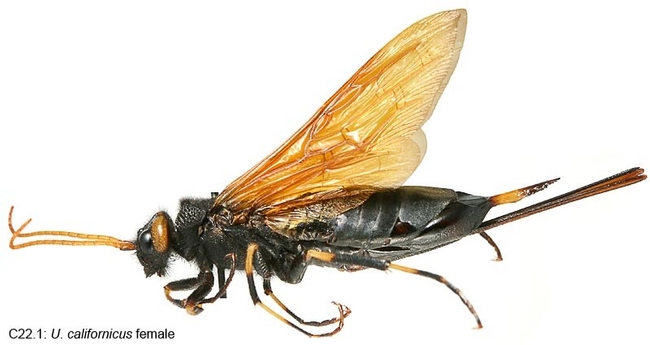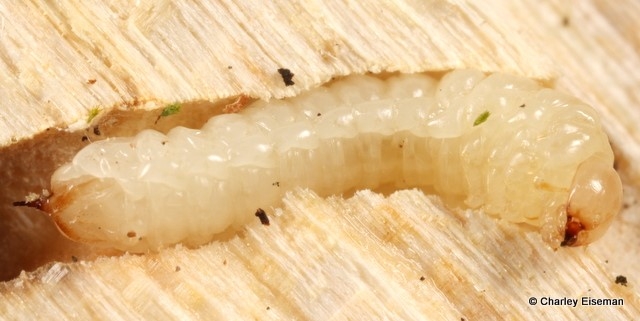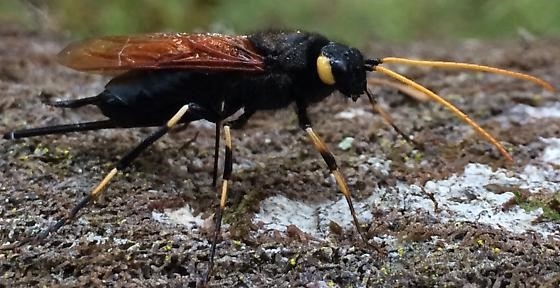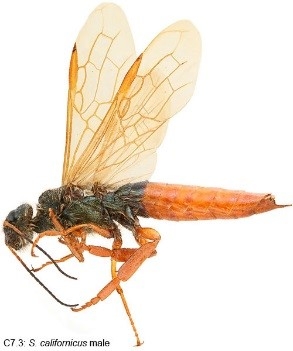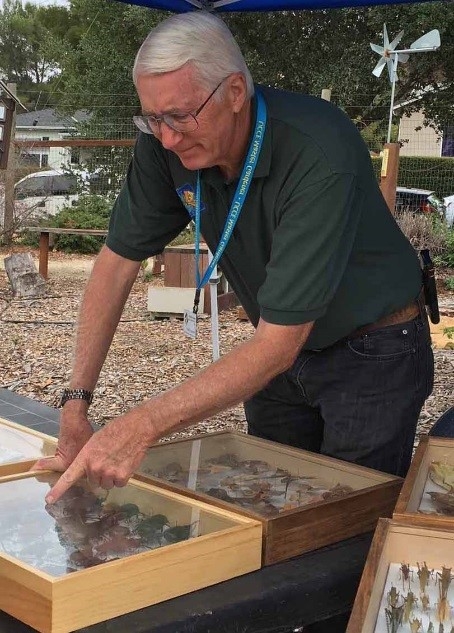Norman Knows...
Horntailed Wasps
In keeping with wood damaging insects, we turn to an unusual group of insects - the wood wasps, also known as horntails. These primitive wasps actually bore in and feed on wood. They are large, almost two inches in length, with a long ovipositor on the female. Males look much like the females, but are usually smaller, and do not have an ovipositor (note photograph). Despite their ability to bore through wood and other tough substances, and their impressive looking “stinger”, they do not bite or sting humans. They have typical wasp coloration, red and black or yellow and black, which gives them some protection from predators.
The larval stage, the stage that bores in the wood, does most of the damage, but never enough to warrant treatment or wood replacement. So what's the problem? It's actually the adult habit of boring through dry wall, hard wood, or wooden flooring that is the main problem. They leave rather large holes in these surfaces, sometimes requiring cosmetic repair. How does this happen you may wonder? These wasps are attracted to dying or recently dead trees, and are often the first wood boring insect into a recently burned forest. In fact, the adults are attracted to smoke. I have spoken with forest fire fighters who have seen them ovipositing into still smoldering trees or logs. It is almost impossible for a logging company to get into a burned forest and salvage the less damaged trees for future lumber, before the wood wasps infest it. During the milling process, without a doubt, many of the developing wood wasp larvae are cut in half, but many are not, and they will continue their development in the 2x4 or 2x6 stud. And, of course, if that stud is used in your new home, eventually that maturing larva is going to emerge as an adult. Some emerge directly from the stud through the drywall, and often the adults are found with dry wall dust on them. If the adult emerges from the stud into a dark space (inside the wall) it will eventually find a place to chew through into the light.
Anywhere from one to a dozen or more can emerge into a home. Often times all the emergence holes will be limited to one room, or even one area on one wall - the one stud that was infested that was built into the home. I even found one that had emerged into my first home in the valley. When I saw the hole in the drywall in our utility room I knew what had done it, and after a short search, I found a dead male in an upturned chandelier light. Most folks will often find them in window sills where they were trying to get outside. Adults do not re-infest into wood from the home. They must have bark on the tree to initiate oviposition - smooth, milled wood is not an attraction. That is why it is not recommended to treat a home that has had wood wasps emerging from some of the studs. Once they are out, they are done. The only problem is that perhaps one or two adults may not emerge in the same year as all the rest, perhaps emerging the following year. But the integrity of the structure has still not been compromised.
I did have one customer though, who was not satisfied with any of my reassurances that her house was not in danger of falling apart and that it was likely no more would emerge into her son's bedroom. Evidently, the emerging wasp frightened the young boy and unfortunately the parents too. They felt they had bought a contaminated home and would not be happy until they got a new one - provided at no extra cost by the contractor of course. Unfortunately, neither I nor the contractor could guarantee that no wasps would emerge from the studs in that home too. I never did find out what happened. Wood wasps can be a nuisance, albeit a short but relatively harmless one. If you ever find one in your new home, please retain it for me. They aren't all that common.
Norman Smith was the Fresno County Entomologist for 30 years. He fielded calls from the general public, pest control companies, farmers, PCA's, etc.; ran the insect trapping program, and gave presentations on insects to many different groups, including lots of schools. Norman has developed a 100,000 insect specimen collection for the county over the 30 year career. Norman earned a Ph.D. in Entomology at UC Davis in 1979.
Norman says...I now enjoy working in my garden, traveling with my wife, golfing and bowling, taking insect collecting trips in the US and overseas in the tropics, and working on some personal research of some small wasps. I also enjoy working with and for the Master Gardener program in SLO.
Attached Images:
